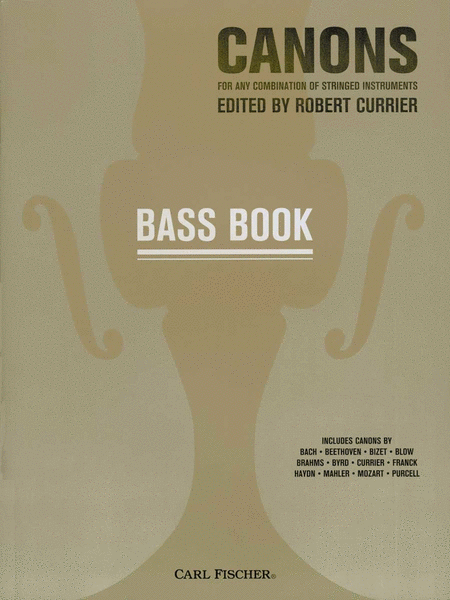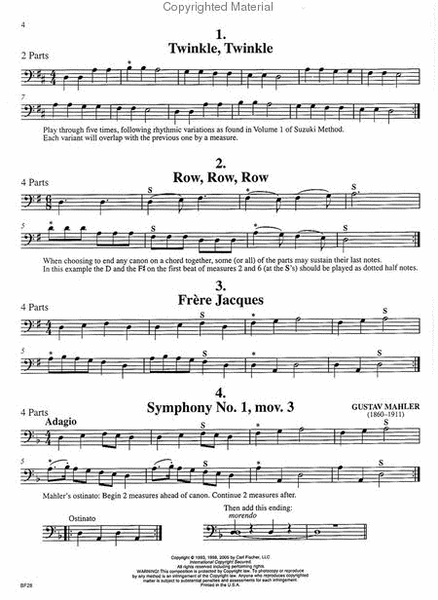Canons For Any Combination of Stringed Instruments
For Any Combination of Strnged Instruments: Bass Book
-
Ships in 1 to 2 weeks
Details
Description
SKU: CF.BF28
For Any Combination of Strnged Instruments: Bass Book. Composed by Antonio Caldara, Cesar Auguste Franck, Franz Joseph Haydn, Gioachino Cocchi, Goodban, Henry Aldrich, Henry Purcell, Johann Sebastian Bach, Johannes Brahms, John Blow, John Eccles, Ludwig van Beethoven, White, William Byrd, Wolfgang Amadeus Mozart, and etc. Edited by Robert Currier. SWS. Collection - Performance. With Standard notation. 32 pages. Carl Fischer Music #BF28. Published by Carl Fischer Music (CF.BF28).ISBN 9780825859793. UPC: 798408059798. 9 X 12 inches.
These canons, selected and edited by Robert Currier, are incrediblyeffective for use in music education, especially as an introduction tochamber music and ensemble playing. They are fun; they are brief andclever; many of them, being vocal in origin, are limited in range andrelatively easy to play.The canons can first be performed in unison until mastered andthen play canonically. They can be played by any combination ofbowed string instruments from a minimum of three up to a fullstring orchestra.This collection has music from the Masters in a form that will amuse,challenge, educate and result in creating true musicianship.
Several characteristics of canons lend themselves admirably to the exigencies of music education, especially as an introduction to chamber music and as an approach to note reading itself. They are fun; they are brief and clever; and many of them, being vocal in origin, are limited in range and relatively easy to play. The melody of a canon may be studied and played in unison by a group until mastered, and only then approached canonically with separate entrances, the melody accompanying itself: a chamber-music experience. And inexperienced participants are better able to hear and absorb the parts sounding around them because these "other parts" are in fact their own part performed at different times.The canons collected here are arranged for all bowed string instruments (violin, viola, cello, and bass) in the same keys and thus may be played in any combination. For example, three or so violinists, violists, or cellists can enjoy playing them, and so can a string quartet or three violinists and a bass or any other combination of players who happen to be available at the moment. Even two musicians can find pleasure in performing canons intended for a larger consort.When mixed instruments are involved, especially ensembles of string orchestra dimensions, the gamut of sound will be broadened and possibilities of contrasting highs and low sonorities - solo with tutti, mixed voices with instruments and such like - are left to the imagination of the performers and their director. There is considerable flexibility here in the number of repetitions, order of entrances and other variables.The number of parts for each canon is indicated directly above the clef sign at the beginning of the canon. Asterisks mark the points at which the first part will have arrived when subsequent parts enter at the beginning. The letter S (for "Stop") marks points where all the parts are simultaneously on a cadential note for ending the piece all together. Of course, it is also possible for each part to end separately, as in traditional rounds.While canons have been composed by some of the world's greatest composers, many of them were spawned as personal jokes among friends. It is hoped that this collection will call attention to some of these relatively unknown, but interesting creations, and give them a locust in today's world of music.


 Share
Share